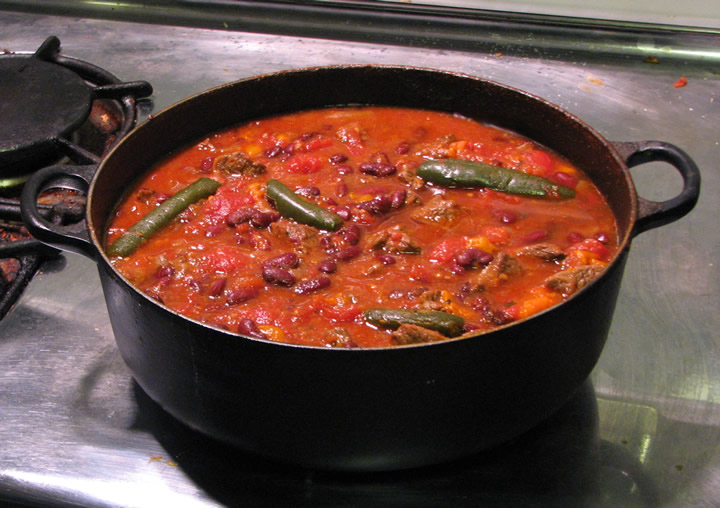Table of Contents > Recipe and Essay German Chili
Cooking Time: PT2H
Cooking Method: boil, simmer
Category: soup
Cuisine Type: German
Servings: 13-16 servings
Related: dbPedia entity
Ingredients:
- 1 lb. hamburger 1 lb. pork sausage 1 lg onion 5 carrots 4 ribs celery 10 lb can diced tomatoes 2-12oz can kidney beans 2-12oz can black beans 8oz uncooked elbow macaroni 1/4c. honey 1/4c. brown sugar 1 tbsp red pepper flakes 4oz chili powder 4oz cumin Salt & pepper to taste
Directions:
- In a (hot) large skillet over med-high heat, add sausage and hamburger. Cook until browned.
- Add honey and brown sugar.
- Then add red pepper flakes, chili powder, and cumin while mixing together cooked sausage and hamburger.
- Add salt and pepper and any other spices to taste.
- Turn stove off and set skillet aside.
- In large stock pot over medium heat, add your carrots, onions, and celery.
- Cook for about 10 min before adding can of tomatoes (water and all).
- Add black and kidney beans.
- Simmer for half hour to two hours depending on how much time you have and how long it takes to soften your vegetables.
- In medium size pot, fill with water and place over high heat until water boils (add salt to water).
- Add elbow macaroni; cook on high (in boiling water) until elbow macaroni is soft.
- Add entire pot (water and macaroni) to stock pot with veggies.
- Add seasoned meat to stock pot, stir ingredients together until sufficiently integrated.
- Salt & pepper to taste, and you are done.
- If serving right away, turn off heat and allow 20 minutes before serving. If not, turn heat level to warm, turning off when ready to serve.

Table of Contents > Recipe and Essay Bonding Through an "Eiting" Family Recipe
Walking into the kitchen of the Eitings' Appleton, Wisconsin house, one could experience infinite possibilities of foods. Being from Wisconsin, some form of German or Dutch dishes are possibilities, perhaps beer-battered brats with sauerkraut and deep-fried cheese curds, maybe a fine schnitzel topped with veal demi-glace and a side of spaetzle, or, if timed correctly, the highlight of the Eiting Family Cookbook, German-style Chili. In a recent dinner table discussion, Kathy Eiting described her favorite recipes, and how she learned to cook them, as well as the importance of home-cooked meals and the family bonds they help to form.
Kathy explained that most of her recipes, whether old German or classic 1950s American, have remained unchanged for generations. Her son Bruce, who not only received his degree in History, but prior to that trained under a European Chef for three years in Classic French cooking, believes it impossible for a single recipe to change hands so many times without being changed itself. Take their German chili recipe. Bruce explained how he tweaked Kathy's recipe the more often he made it: seasoning the meat rather than the chili, or thickening it to an American-style chili rather than her traditional broth-heavy method. Each time a new person follows the recipe they add their own originality to it.
Agreeing with her son in this particular case, Kathy admited to altering her recipe from the one her mother, Florence, taught her. In Kathy's childhood, her mother used Campbell's tomato soup and Heinz ketchup, which many considered a delightful shortcut in the modernized 1950s kitchen. Finding the idea of using concentrated, processed tomatoes "just plain silly," Kathy began using freshly canned diced tomatoes, giving it a fuller flavor. Florence's mother would not have had Campbell's tomato soup, so they determined its use was Florence's alteration. Generations of our German ancestors probably repeated this tradition and used anything they were able to harvest from their fields.
As Kathy and Bruce sat around the table reminiscing, both came to a stunning realization. They shared a moment normally reserved for the end of a Louisa May Alcott novel. Bruce blurted, "When I was 15, did you ever think we would be here having this moment?" To which Kathy replied, "Not in a million years." Half a lifetime ago Kathy was a distraught mother with an out-of-control teenager. For twenty years they forced a friendship while under the same roof. After Bruce left home, requiring him to cook for himself, their rapport began to grow almost effortlessly. As Bruce's culinary interest grew, so did their relationship. Suddenly they called each other regularly to share ideas and exchange recipes; they spent hours together in the kitchen cooking and catching up. They opened up a bond that had been under the surface all these years, yet neither knew how to bring it out until they spent time in the kitchen, working together to develop a fine meal, and parlaying that into a great friendship.